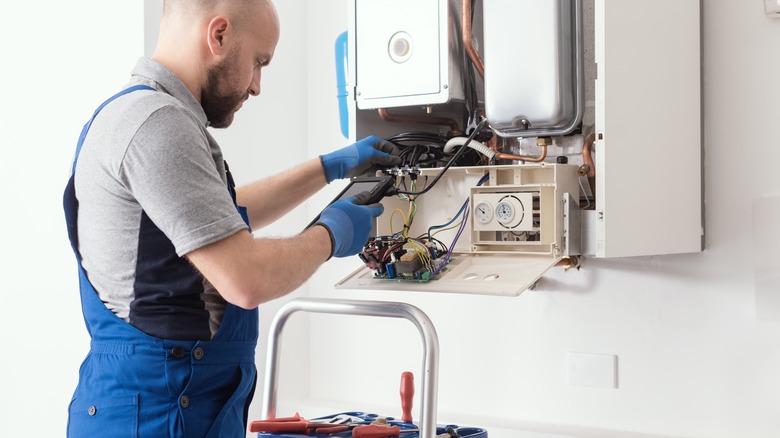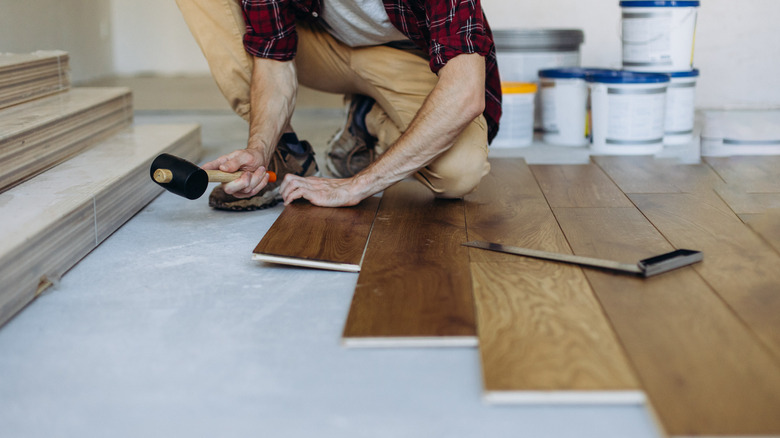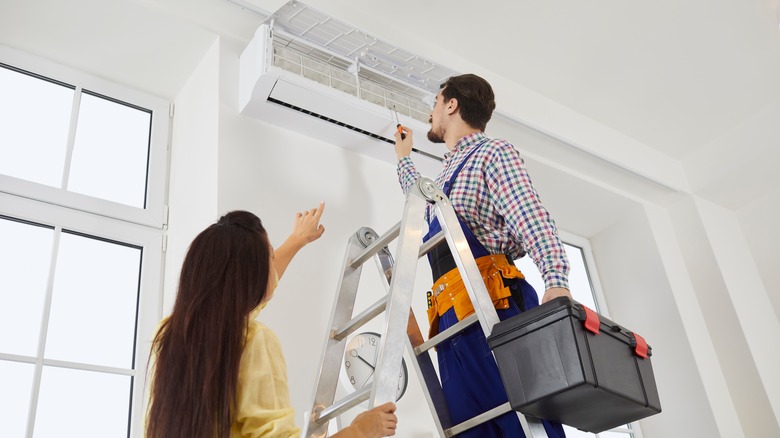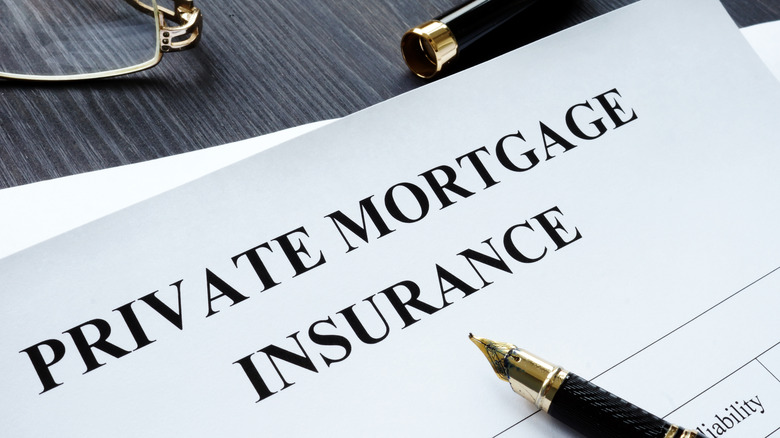All The Extra Expenses That Can Sneak Up On You When Buying A Home
Owning a home is the epitome of achieving the increasingly impossible American Dream. In fact, 84% of Americans aspire to climb up the home ladder, according to a LendingTree survey. But the journey is far too onerous for some, with over 49% unable to save enough to make a down payment. So, it's no wonder that when thinking about home ownership, most Americans resolutely focus on setting aside enough money for upfront payments and improving their credit scores for better mortgage terms. Unfortunately, this alone isn't enough, and there is much more to the financial calculations.
From closing the deal to moving and living in your new abode, you're likely to run up several other expenses — such as closing costs, inspection and appraisal fees, HOA charges, moving costs, utilities, and more — that you perhaps did not anticipate when getting ready for the big purchase. To truly enjoy the fruits of homeownership, and avoid draining your bank account unexpectedly, prepare yourself better by accounting for the following overlooked expenses.
Closing costs
Affording a white picket fence isn't limited to arranging the monthly mortgage payments; it also involves paying for other fees at the deal closing. While the list varies based on the agreement reached between the buyers and sellers, buyer closing costs mostly involve financing, such as application charges, loan origination fees (around 1% of the sanctioned amount), and escrow payments. Home checks like deed transfer taxes, home inspections, title insurance, deed recording fees, appraisal charges, and attorney fees also constitute closing expenses. Rocket Mortgage estimates that these costs can add up to between 3% and 6% of the mortgage loan.
Purchase price, financing options, and location influence how closing costs are calculated, with the average sitting at about $6,905 per ClosingCorp. However, it ranges widely, with homeowners incurring as little as $2,061 in Missouri but $29,888 in Washington. On top of that, you may need to dish out context-based, special charges, such as flood insurance and title fees. Luckily, these costs aren't set in stone and are negotiable with the seller and the lender. Before closing on a house, shop around for better terms or demand lender credits. If that doesn't suffice, seek local grants or roll closing costs into mortgage payments to make them easy on the pocket. For instance, Bank of America provides up to $7,500 toward one-time expenses through their Our America's Home Grant program.
Home inspection costs
While not mandatory, you should consider hiring a professional to inspect your potential investment — even more so if you're buying an old house, as it can bring out all the previously unnoticed structural issues and concerns that can later stress your wallet. On average, a professional inspector charges $340 to thoroughly examine an existing home's plumbing, roofing, electrical, windows, foundation, HVAC systems, attics, exteriors, and more, but it can reach up to $500 in some cases, reports Forbes. However, in new construction homes, you can get a pre-drywall inspection done for under $300.
The amount you hand over to the inspection company is ultimately determined based on the property's age, size, and location. For example, some inspectors charge a flat fee for areas under 2,000 square feet and charge nearly $25 for every additional 500 square feet (via Angi). You might even score a discount if your mobile home or condo is under 1,000 square feet. However, charges can soar higher if you get specialty inspections done, particularly for mold, termites, or radon. Leverage these results as a bargaining chip to get the seller to lower their ask price, assuming these findings haven't marred your zeal to acquire the property. To do that, though, ensure you've hired a reputable inspector who can clearly answer all your questions about their home inspection process.
Moving and packing costs
In the euphoria about successfully buying your dream home, you might lose sight of the costs involved in actually moving into the place. Alas, the costs aren't limited to hiring a moving company. Rather, you'll incur multiple expenses, such as buying packaging supplies like cardboard boxes, bubble wrap, labeling markers, tape, and additional storage units if you don't plan to use some of your things immediately after the move. You may even need to eke out extra for car insurance. All in all, your moving costs increase if you need to transfer a heavy load, hire day labor, and trek a considerable distance (even higher for interstate and international transfers). Moreover, relocating during weekends and busy seasons can cost you more than weekdays and off-seasons.
While estimates vary, moving out of a two- or three-bedroom household is typically priced between $800 and $3000, per RealSimple. However, long-distance or international moves can cost upwards of $2,700, going as high as $16,200 in certain cases. Even if you choose to DIY by renting a truck, spending $130 or $1,780 for a local or long-distance move, respectively, is a given, notes Move.org. Budget even more for carrying your prized piano or artwork, which are packed specially.
Maintenance, upgrades, and renovation costs
Admittedly, the hardest part after moving is drawing up and sticking to a repairs and maintenance schedule, as acknowledged by over 36% of new homeowners in LendingTree's survey. While it's obvious you'll fork out a pretty penny to add new furniture and furnishings (especially if you're moving to a bigger home), as well as on house repairs, it doesn't stop there. Landscaping, pressure-washing, gutter cleaning, security, HVAC repairs, and pest control barely encapsulate its full scope. According to Porch, average annual home maintenance costs come in at about $16,000.
Not to mention, your location affects your annual payouts, too. For example, Washington DC-based homeowners face a $18,119 outlay compared to $14,890 for Mississippi residents. As a general rule, budget 1% of the home value, or $1 for every square foot of space, for routine maintenance. Allocate a higher sum if you want to upgrade or remodel your home. For instance, Hedgefield Homes estimates that customers can spend between 10% and 20% of the purchase price on renovations and necessary home improvements. In addition, apportion a certain amount for emergency spending — Angi averages it to just under $2,000. To save on repairs, maintain your abode proactively.
HOA fees
If you're buying a condo, a townhouse, a co-op, or moving to a gated community that is run by a homeowners association (HOA), you must budget for their monthly fees. While the fine print differs across the communities, these resident-led organizations usually undertake basic maintenance — especially of the public, shared areas, such as parks, clubhouses, and the pool — for a price. Some even offer amenities like lawn care, outdoor recreation, concierge services, and trash pickup, inflating the charges further. Basically, the more amenities you get, the more you'll have to shell out. In fact, DoorLoop notes that almost 35% of owners pay HOA dues that exceed their mortgage payments.
Further, many HOAs deposit a certain percentage of the collected fee into a reserve (emergency) fund to meet extraordinary expenses, like a roof repair. However, when the renovation cost exceeds the reserve amount, you might be hit with a "special assessment," or additional charge. In total, HOA dues run a gamut between $100 and $1000 annually, showing it can clearly range quite a bit. Plus, keep abreast of the HOA's track record of raising dues over the years. Keep up on your HOA payments without fail to avoid penalties or getting a lien.
Homeowners insurance
Home insurance might not seem compulsory, but it might as well be. Pretty much all mortgage lenders expect homeowners to buy insurance on their property to guard against internal or external damage, accidents, and theft. Although personalized, homeowners insurance almost always provides coverage against impairment losses from vandalism, hurricanes, or fire incidents. However, it generally excludes common damages like natural disasters, mold, drain backups, and pest infestations. Given how home insurance has various protection levels from HO-1 to HO-8, based on your perceived level of risk, estimating premium payments isn't plain sailing.
Insurance companies use your credit scores and previous claim records to determine terms. So, the better the credit history, the lower the homeowners insurance payments. But if the real estate's previous owner has filed several claims over the last three to seven years, it can affect your premium adversely. Further, your home's building material and location influence the insured amount, as do supplementary coverage options for special items, like artwork and jewelry. Considering this, Forbes estimates that, on average, homeowners shell out $1,582 in annual premiums against a $350,000 mortgage — although the rates can sink lower to $364, as seen in Hawaii, or rise sharply, reaching $3,651 in Oklahoma. Nevertheless, you must pay the first installment immediately when the deal is clinched.
Property taxes
Similar to maintenance costs, property taxes also take a toll on a homeowner's finances. However, planning for them is a complex endeavor. Legally, all property owners must pay a real estate tax to their respective local or state authorities. While mostly annual, some states demand bi-annual or quarterly payments that you either pay for directly or have the mortgage lender pay on your behalf as they collect the amount through monthly installments. The final outlay differs further because of exemptions and tax advantages.
Property taxes are assessed based on home value and the ordained tax rates, which can go as low as 0.28% in Hawaii or as high as 2.49% in New Jersey, per World Population Review, ultimately averaging around $2,459 annually. However, not all properties are subject to an ad valorem tax, with low-income earners gaining an exception. Similarly, some senior citizens, disabled people, and veterans can earn a homestead exemption, which disqualifies a certain percentage of the property value from taxes, lowering the outflow. For instance, Massachusetts exempts 5% of the real estate value from tax assessment, so for a $200,000 home, no taxes are levied on the $10,000 portion. To further save on property taxes, appeal your home's taxable value if you find any inaccuracies on your tax card or find precedents of lower valuations in your neighborhood.
Home warranty
New homeowners often splurge on a home warranty to curtail appliance repair expenses down the line. This rings true for those buying homes with older equipment that is well past the manufacturer's warranty period and risks burning a huge hole in your pocket upon breaking down. A home warranty assures owners that the third-party service provider will foot the repair bill of electric appliances (dishwashers, refrigerators, and their ilk), plumbing systems, and HVACs when they pay a minimal service fee ranging between $50 and $150 a month. Warranties on septic systems, pool pumps, roofing, and other uncovered add-ons are available, too, at an extra cost.
As bigger houses tend to have a greater number of advanced systems, their home warranties cost more. The charges also depend on the company hired, its service plans, and the property location. Accordingly, as Forbes' estimates, a home warranty can cost between $275 and $1,425 every year. The only drawback is that some companies limit the repair amount, forcing homeowners to pay on top of their annual warranty payments.
Impact fees
Another element that's likely to catch you by surprise is an impact fee levy. Local governments charge residential (and commercial) buildings a one-time fee in the garb of an impact fee to compensate for the excessive strain inflicted on public utilities due to the new construction. The rationale is as residents increase, so will the demand for roads, schools, fire services, parks, wastewater, and other amenities. So, residents are required to pay for their infrastructure use through a regulatory charge, usually arrived at after considering the property size, its impact, and overall costs.
Technically, these cash proffers are imposed on real estate professionals and developers. But, they're quickly passed on to new homeowners or to buyers of properties aged 10 or less. For instance, in Oakland, CA developers shell out $4.08 per square foot of residential construction as a school impact or mitigation fee. New units are also charged fair-share fees on transportation, affordable housing, and jobs. Again, the charges vary vastly across cities and states, with New Hampshire recording between $25,000 and $30,000 per unit in impact fees versus no fee in Michigan. Also, some local governments exempt affordable housing units from this levy.
Utility costs
Even though paying for utilities shouldn't entail any surprises, it still does, even more so if you've previously been renting and paying a consolidated bill. At the same time, upsizing or moving into a bigger house can significantly raise your electricity, water, sewer, and gas bills, while also calling for new additions, like trash and recycling services. Add inflation to the mix, and the charges can increase exponentially.
Typically, utility expenses depend on factors like the number of family members, home size, energy efficiency, and property location. Forbes notes American households average around $430 in monthly utility expenses, though the actual number can vary greatly by state. Given how electricity constitutes the majority of the expenses, climate plays a pivotal role in what drives your utility spending higher. So, when computing the cash needed to purchase a home, don't skip on utility payments. Talk to the neighbors or the seller to get a better idea about your future expenses.
Private Mortgage Insurance (PMI) costs
PMI represents another expense that some potential buyers may be saddled with if they can't put down 20% of the home value as a down payment. It applies if you need to refinance your mortgage with under 20% home equity. To illustrate, considering the median sale price of a home is $431,000 (as of October 2023), you must pay $86,200 upfront to avoid incurring PMI expenses (via Federal Reserve Bank of St. Louis). At the risk of sounding counterintuitive, PMI is paid to assure and protect the lender, not you, against loan defaults.
The way it works is that your lender links you to an insurance company, which, based on your credit scores, loan type, and loan-to-value (LTV) ratio, calculates the premium cost. A strong credit history and bigger cash downs will put you in the lower range of 0.46% to 1.5% PMI (per Urban Institute), but availing adjustable-rate mortgages (ARMs) will push you to the higher end. You can, then, either pay the premium along with the closing costs or combine it with your mortgage by paying additional interest. While PMI cancels automatically when your LTV touches 78%, it's best to reach out to the lender on your own.
Deed transfer taxes and fees
While not applicable in all states (including Alaska, Kansas, Texas, Mississippi, and more), many local governments subject a home deal to real estate transfer taxes or deed transfer taxes. Unlike property taxes, these are non-recurring and are usually clubbed with the closing costs. Local governments charge a specific amount on the purchase price in exchange for transferring the property title to the new owner and registering the sales deed in their name.
However, as these governments stipulate their own rules, deed transfer costs fluctuate widely across the country. For example, Arizona charges a nominal $2 fee for every transaction, while New Hampshire charges 1.5% of the home price as transfer taxes. Moreover, the onus of meeting these expenses doesn't lie on the buyer alone. States like Delaware suggest splitting the tax, whereas the distinction is more explicit in California, with buyers in Northern California expected to shoulder the entire burden, and it being the opposite in the southern end of the state. Although not tax-deductible, these taxes raise the tax base, which is useful for decreasing capital gains tax.












